When you create an online course, it’s important people actually complete it.
Why?
Because when engagement is low…
….refunds and bad reviews are high.
The mistake most course creators make is:
They don’t think past the sale.
Here are my best tips to increase student engagement, so you can get more people to complete your course.
What I’ll cover…
Here’s what I’ll cover in this guide:
- The Problem With High Dropout-Rates (Hint: It Hurts Your Bottom Line)
- Why Online Course Students Tune Out: The 3 Most Common Reasons (And What to Do About It)
- How to Get Students to Commit to Your Course
- How to Use the Power of Small Wins to Keep Your Students Motivated
- How to Create an Incentive to Finish Your Course
- How to Create More Engaging Course Content (Video)
- How to Use “Teasers” to Guide Students from Lesson to Lesson
- How to Use Re-Engagement Emails in Your Online Courses
- How to Build a Supportive Student Community
- How to Use Quizzes (and Polls) to Motivate Students
- How to Find Out WHERE Students Get Stuck
First, let’s talk about why high dropout rates are a problem.
The Problem With High Dropout-Rates (Hint: It Hurts Your Bottom Line)
So you created an online course…
Your first round of students is signing up.
Then you look at your stats.
Uh-oh.
People are dropping out FAST.
In other words, engagement is low.
Is it because you created a bad course?
Not necessarily…
Student engagement has little to do with the quality of what you teach. So, if people don’t finish your course it’s not because your material is bad.
In fact, you could create the greatest course in your niche… and you might still see high dropout rates.
The stats suggest that that’s exactly what’s happening to many course creators. The average completion rates for online courses are around 13%. It basically means…
Only 1 out of 10 students will actually complete your course.
That’s pretty bleak.
And it gets worse with each lesson…
Take a look at this:
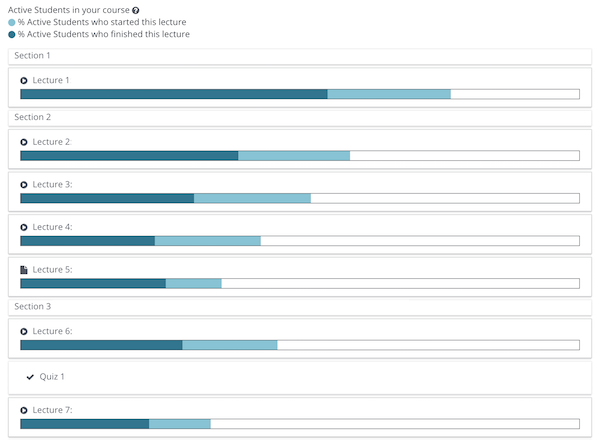
What engagement looks like for most online courses
With each lesson, engagement drops lower and lower.
This is a problem in 3 major ways:
- You don’t get a chance to actually help people with your course (not very satisfying)
- Students get frustrated because they don’t get results
- You have to deal with refunds, complaints, and bad reviews
Plus, you don’t get any of the benefits from happy students. You know, like raving reviews you can use for testimonials, case studies, and word-of-mouth marketing.
Now, it’s NO surprise this happens…
Apparently, people’s attention spans are now shorter than those of goldfish.
Thanks, Internet!
But blaming short attention spans doesn’t solve the problem. If you see such a massive drop off in student engagement – you’ve gotta fix it.
The question is…
How?
Why Online Course Students Tune Out: The 3 Most Common Reasons (And What to Do About It)
The first step to solving a problem is understanding what’s really going on. So, WHY do students get disengaged from online courses?
Let’s start by realizing one thing:
Online courses are different than learning in person. Unfortunately, most self-guided courses don’t take this into account. Basically what you get is a “recording of a lecture.”
But that’s not what keeps students engaged.
Heck, I regularly dozed off in college – even when I was sitting right there in class 🙄. Watching a video of a lecture at home only makes staying focused harder for your students.
Of course, online courses are different. People who buy your course WANT to learn what you teach.
And still…
People drop out. The first big reason is simply…
Dropout Reason #1: Students get stuck
I’m not even talking about getting stuck in the training (that happens, too, but more on how to fix that later). I’m talking about getting stuck with things like…
- Finding their login information
- Where/how to download worksheets
- How to contact support
…and a bunch of other “technical” or “administrative” difficulties. I know, this shouldn’t even be a problem. But it is.
For many of your students, it will be the first time taking an online course. It’s your job to prepare them for the online learning experience.
That’s why it’s important to always give crystal clear instructions.
Tell them what to do next. Where to find what. What to do if they fall behind, lose their login, or forgot how to turn their computer (kidding…).
I address this problem in 2 ways in all of my course.
First, I use Zippy Courses as my course platform. After all, we built it with usability for students in mind.
It gives people clear navigation from lesson to lesson:
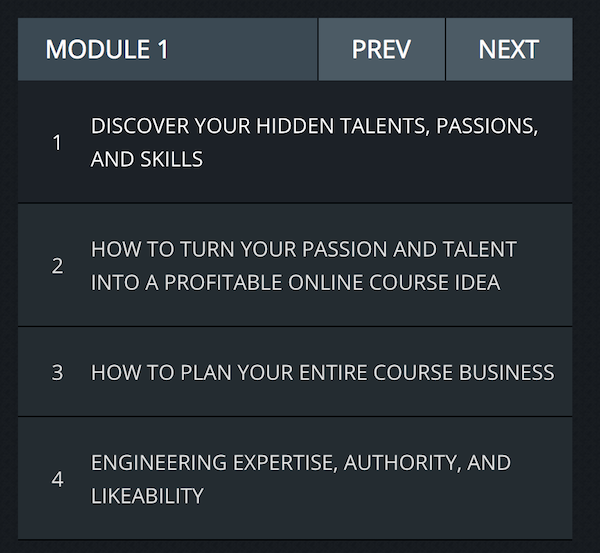
Clear course navigation helps your students not get lost.
Then, I also create a detailed “Course Welcome Page.”
This is where I’ll list all the “housekeeping items” students need to know.
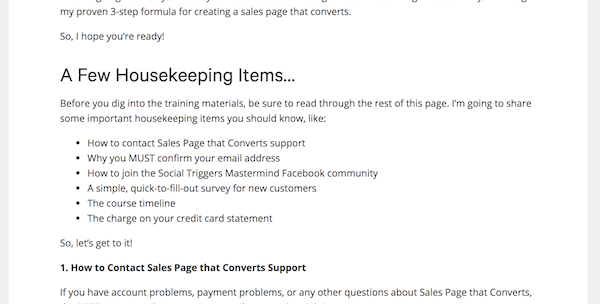
Put important information on your course welcome page!
Here’s what I’ll usually include:
- How to contact support
- Why people need to confirm their email address
- How to join the course community (my Facebook Mastermind group)
- Link to a welcome survey
- The course schedule (my flagship courses are multi-week, in-depth courses, so this is important)
- The charge on their credit card statement (people sometimes get confused, so we tell them exactly what they’ll see on their credit card statement)
I’ll talk more about some of those points.
For now, remember:
A clear and complete welcome page can really help people navigate your course. So, I suggest you add one for all of your courses.
What about the other reasons people drop out?
Well…
Dropout Reason #2: Students get busy with other things
The second reason is that students just get busy with other stuff.
Yup. When they sign up they may be “OMG so excited!”.
Fast forward to 2 weeks later and they haven’t logged in because… life.
To be honest, I don’t blame people for this. Like I mentioned above, for many people, it’s the first time taking an online course.
And the reality is:
Most people are bad at time management. It helps if you tell people in advance how much time they need to set aside to go through the course. But more importantly…
You need to constantly remind your students why they signed up in the first place.
I’ll show you how to do this with engagement emails and some of the other tips below.
This ties right in with the third reason student engagement may drop…
Dropout Reason #3: Students lose motivation
Not having time can be an excuse for, well, losing motivation.
I believe in the value of courses. Courses have changed my life. I see how my course helps thousands of people start and grow their businesses.
BUT.
Some people think that just by BUYING a course, they’ll solve all their problems. They forget that they still need to do the work.
Side note: Not all dropouts are created equal.
I’ll explain…
A student may sign up just to get access to a specific part of your training. For example, I know some people signed up for my blogging program Blog that Converts specifically for the promotion strategies.
Now, I don’t recommend this, because my programs are built as complete step-by-step systems. They’re also multi-week trainings, so I release them on a schedule.
But if you give people instant access to your full course, some people may only be interested in certain lessons.
Not much you can do there. Also, nothing you need to worry about. Just be aware that this happens.
So, to summarize the 3 reasons…
Students get disengaged because they get stuck or confused, lack time, or lose motivation.
Now, let’s look at all the ways you combat these reason.
How to Get Students to Commit to Your Course
Studies show that when people make explicit commitments, they’re more likely to stick to them. That is: when we tell others – or even just write it down – we’re more likely to follow through.
You can use this insight to increase student engagement in your online course. How? Make people sign a “course commitment.”
Here’s an example from my training for freelancers and service providers, More Clients Every Month:
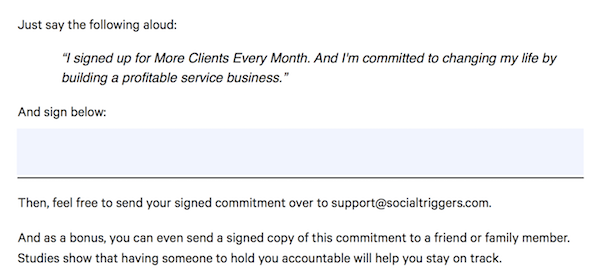
Get people to commit to your online course
It works because it’s true that those who do nothing, achieve nothing.
It’s best you do this at the very beginning of your course, obviously. This is when your students are the most motivated to take action.
Get them to commit now, and they’ll be more likely to follow through later in the course, too. And that’s the goal.
What’s beautiful about this. It’s so simple, to do. You can add it to your course (or courses) today. Heck, you can steal my script if you like:
I know you want to [outcome of your course]
And that’s awesome!
But the truth is:
It’s gonna take some work.
That’s why I want you to commit to sticking with me throughout this training.
Now, studies show that writing down (and better yet: sharing!) your commitment can double your follow-through. So…
Say the following aloud and then sign below: [commitment to training]
A written commitment like this is the first of many “small wins” your students should experience as they progress through your course…
How to Use the Power of Small Wins to Keep Your Students Engaged
All of my courses are built around milestones – important steps on the path to the end goal of the course.
For example…
Let’s think about the milestones for a language course to “master small talk.” They might be something like:
- Milestone 1: Learn how to say “hello and goodbye.”
- Milestone 2: Learn to “talk about your hobbies.”
- Milestone 3: Learn to “talk about your work.”
- Milestone 4: Learn to “talk about the weather.”
- Milestone 5: Learn to ask questions.
Do you see how each milestone is an important step to mastering small talk in a foreign language? This means student engagement starts with how you OUTLINE your online course. So, think about the small wins along the way until people reach the big outcome.
Remember:
People don’t care about your course. They care about the outcome and result they will get.
So, always explain – or better yet demonstrate – why each milestone is important. Show your students how each step takes them closer to the end goal they want to reach. Show them what they’ll be able to DO.
But “small wins” can be… even smaller.
I’ll explain.
Small wins are not just about results.
It’s just as much about how you make people FEEL.
Let’s say you’re teaching a photography course. Maybe one big insight is…
“To take better photos you don’t need a more expensive camera. It’s about how you frame your shots that will make them look better.”
I’m not a photographer, so I just made that up. The point is this:
Success is a great motivator for students. So you need to constantly remind them what they just learned. That way they’ll feel like they’re moving forward every step of the way.
That’s how you keep students happy… and engaged. Which means, they’re less likely to drop out.
How to Create an Incentive to Finish Your Course
A commitment in the beginning – check.
Small wins along the way – check.
What’s missing?
A big incentive at the end.
I already mentioned that people care about the impact your course makes. It’s not about what you teach. It’s about what students can do with it and how it makes their lives better.
But there’s something else you can do to give people a reason to actually finish your course.
Take a look at this:
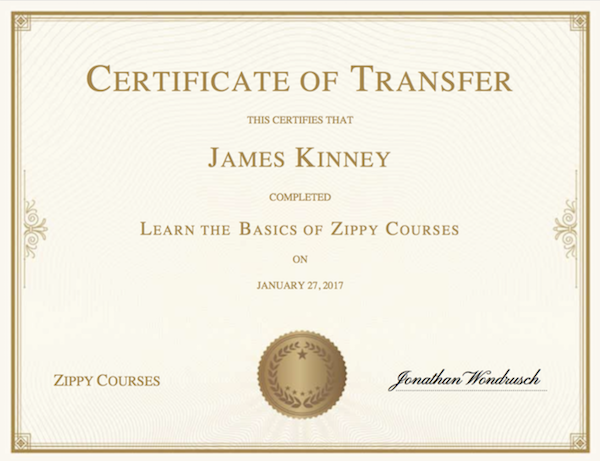
A certificate of completion (created with Zippy Courses)
It’s a… certificate of completion.
I created this one with Zippy Courses. Now…
What do you think happens when you do this? Okay, that’s a rhetorical question. It’s obviously an additional incentive to complete your course.
For students, this is immensely gratifying. Because we all like to “get things DONE”.
(A little too much, actually – see completion bias.)
Plus, it’s an easy way to give your students a useful, tangible result. They can use it to signal their skills. Here are a few more certification examples:
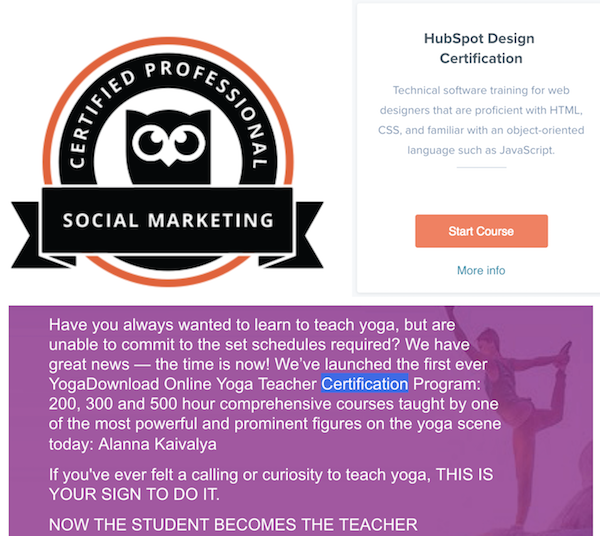
Examples of online course certifications
Certifications are one form of a completion bonus. But you could offer other incentives, too. Some ideas to think about:
- Certification
- Free bonus training
- Discount for another course
- Special offer for consulting
You name it…
If your dropout rate is high, a certification – or another completion bonus – should help. Frankly, I’m not sure why only a few online courses do this.
How to Create Engaging Course Content
I already talked about the “structural” things you can do to increase the engagement in your courses.
But what about your actual content?
How can you make sure people don’t tune out in the middle of your lessons?
Basically, you don’t want to be this guy:
And I have some suggestions 🙂
First, keep your lessons small-ish.
Remember how I told you people have shorter attention span than goldfish? Right. Well, it’s not quite as bad…
When people actually want to pay attention, they can keep it together slightly longer.
How long?
10-15 minutes.
At least that’s what neuroscience tells us.
That’s why I try to keep my course lessons pretty short. I know, this can be tough, when you’re covering lots of material and big concepts.
More important than the length of your lessons is the “Rule of One”…
It means:
Don’t try to cover more than ONE topic per lesson. In fact, it might be better to break up big topics into subtopics.
Going back to the language course example:
Instead of one lesson about “How to make Small Talk in Spanish”…
…create a “Small Talk” module with 3 lessons:
- “How to talk about what you do”
- “How to talk about your hobbies”
- “How to talk about the weather”
Now…
Since most online courses feature video lessons, how do you create engaging videos? I recently talked about it in my daily vlog, Planet Derek (subscribe to my channel):
Oh, one thing I forgot to mention:
Keep it fun.
I’m not saying waste people’s time. They want to learn. But it’s important you break up the pure information. It’s okay to throw in a joke and some personality.
Remember:
A lot of students will buy YOUR course because of YOU.
Give them what they want!
That’s how they’ll stay engaged.
How to Guide Students from Lesson to Lesson with “Teasers”
You know how TV shows always cut to commercial right when it gets interesting? You can use the same “teaser” strategy to create a more engaging online course.
Here’s what I do:
At the beginning of every lesson, I tell students what they’re about to learn.
Then, throughout the lesson, I tell them what I’m about to talk about next.
At the end of the lesson, I tell them what to expect in the next lesson.
Why do I do this?
Because curiosity is a powerful force. And the secret to making people curious is creating an information gap.
I already wrote about how to use information gaps.
In short:
Whenever there’s a gap between what people know and what people WANT to know, there’s a curiosity gap.
Let’s say I’m teaching a web design course. I might say something like this:
“I just showed you how to change the size of this font. But how do you change the size of these images? I’ll show you in a second. But since we’re talking about fonts, I’ll show you how to change the color first.”
Do you see how I opened an information gap?
Actually, I opened TWO information gaps: How do you change the size of images? And how do you change the font color?
Moving on. What else can you do to get more students to complete your course? One of the most important things is sending re-engagement emails.
Let’s talk about it.
How to Use Re-Engagement Emails in Your Online Courses
As I told you, many of my courses are multi-week programs. The content gets “dripped out.” Meaning, students don’t get access to the whole course at once.
Instead, each module (usually 4-5 lessons) gets released separately
This results in a higher completion rate. Why? Because it give me the opportunity to send re-engagement emails.
Here are the 3 types of emails I send:
- Welcome Email (right after they sign-up for the course)
- Weekly Module Email (an email when each new module gets released)
- Completion Email (when the training is complete)
What goes in each type of email? Remember, to keep people moving through the course, you need to CONTINUALLY remind them why they signed up in the first place.
Let’s talk about the welcome email.
First, I remind people that they made a smart decision by signing up:
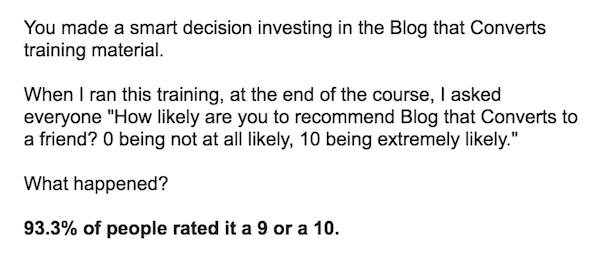
A good example of a course welcome email
Then, I send them a link to the course welcome page. Remember, this is the page with all the important information about the course.
Now, what you’re probably wondering is…
What do I put in my weekly re-engagement emails?
I always follow the same template. Let me show you:
Hey [NAME],
I just added Module 2 inside the membership area for More Clients Every Month. Module 2 is all about perfecting the process of turning prospects into clients.
I’ve found that a lot of service providers face the same dilemma:
You’re great at doing what you do… but you’re not so good at selling it.
That’s why, in this module, I’ll share a natural, but effective way of selling your services without being “pushy” or “sales-y.”
Here’s what you’ll learn in Module 2:
[Lesson teaser 1]
[Lesson teaser 2]
[Lesson teaser 3]
[Lesson teaser 4]
[Lesson teaser 5]You can access Module 2 right here: [Link to course module]
I’ll see you inside!
You can follow the same template:
- Tell them what the new lesson is about and how it fits into the big picture of your course (how will this particular lesson help them get a step closer to the end goal?)
- Highlight the key insights people will get (use “teasers” by creating information gaps)
- Link to the new lesson(s)
Sure, this works best if you “drip” your course…
But even if you release your course all at once – send re-engagement emails to keep your students on track.
Cool? Cool.
What else can you do to keep students motivated?
How to Build a Supportive Student Community
A supportive student community is an often overlooked but important part of keeping your students engaged.
What do I mean by “student community?”
It’s pretty simple:
Create a space where students can connect and communicate with each other.
At Social Triggers, we use Facebook for this – all of our students get access to the Social Triggers Facebook Mastermind Group. You can use Slack, or any other platform you like.

Create a community for your students
A supportive community is one of the most important things for effective learning. It gives your students an opportunity to ask questions, get feedback, and share their big and small wins.
Don’t forget to interact in the discussions!
People will want to interact with you. For you, it’s actually a great way to let students know they’re on the right track or how they could improve.
You can also drive the conversation with regular threads. Think “Wednesday Wins” or “Q&A Friday.” You start the conversation, and students can join in.
All of this will help you keep your student dropout-rate low.
Here’s a bonus tip:
Studies show that people are 5x more engaged and 16x more likely to finish an online course when they’re part of a group.
So how about matching up 3-5 students into accountability-groups?
We’ve talked about this behind the scenes, but I’ve never actually tried it. I think it could be a fantastic idea.
How to Use Quizzes (and Polls) to Motivate Students
The academic publishing giant Wiley found that polls and quizzes increase student engagement.
Remember how I talked about small wins?
Well, a quiz is just that.
Students can SEE their progress.
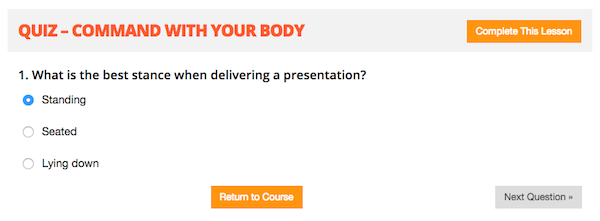
Quizzes keep students going.
If they pass. If not, it’s a good way to measure whether people are ready for the next lesson. In Zippy Courses, you can create quizzes that are optional or required.
(I generally don’t suggest you make passing a quiz a requirement. But you can test and see what works best for you.)
How to Find Out WHERE Students Get Stuck
As we saw, students drop out and get disengaged for all kinds of reasons…
Technical difficulties. No time. No motivation.
You can remedy a lot that with the tried and tested tips I shared here.
But what if there’s an actual hang-up in your course?
That is, people keep getting stuck. And everyone is getting stuck at the same place.
How do you find out? And what do you do then?
Well, one way to find out is with a survey.
That’s why I always send a completion survey AFTER the course is completed.
The important question to improve your completion rate is this one:

Survey: “What didn’t you like about the course?”
What DIDN’T you like about the course? What can we do to make it better?
I also make sure to include reminders that students can contact support.
Why? Because many people will hesitate to ask for help when they get stuck. But that’s not good for them and it’s not good for you.
For example, on my course Welcome Page:

Make it easy for your students to contact you.
Students need to feel heard. They need to know that there’s help available when they need it.
If they feel ignored, they’re more likely to drop out. And they for sure won’t tell anyone about how awesome your course is.
Phew!
We’ve covered a lot here!
Student engagement in online courses is one of those topics that doesn’t get a lot of attention. Not enough. Considering it’s an important part of a successful online course experience.
The good news is:
If you follow the best practices I shared here, you should see an improvement in student engagement.
Remember… Happy students = better results for you.